Stone, minerals and semiprecious of the world stone
Oxide and hydrooxide: Opal -->rus
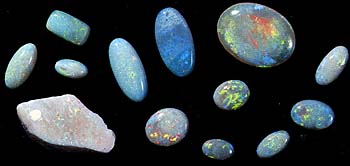 Diagnostic cart.
Diagnostic cart.
Si O2 * n (H2 O)
Crystal structure amorphous
Hardness on the Mohs scale 3-3,5
Specific unit weight mass 3,96
Cleavage perfect absolute along bottom base
Fracture, break wrong
Colors colourless, multicolors
Colors in powder triturate white
Glance (glitter, glare) from glass to mother-of-pearl
The name "opal" happened from sanskrit "fallen" down - "jewels color stones". Select three groups of opals: overflowing noble opals, fiery opals and widely widespread ordinary opals. Considerable vibrations register in their physical properties.
Noble opal. The feature of noble opals is opalescence is an iridescent game of flowers, changing with every turn of stone. As early as 60th of XX century explained it the refraction of light on the thinnest plates. An electronic microscopy at a 20-thousandth increase allowed to set veritable reason of this phenomenon: composing opal the shallow marbles ("globule") of low temperature cristobalite, well-organized submerged in gel mass of silica, are stipulated by the difficult phenomena interference of light. Noble opal therefore, strictly speaking, quite not is amorphous mass truly.
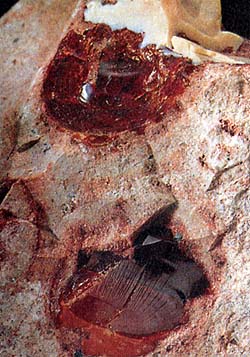 On a photo a standard of fiery opal is from Mexico. Down: noble opal. Opal always contains water - from a few to 30%. In course of time stone can lose it. Thus it becomes fracturing and him opalescence dims. At saturating with butter, it is disappeared a spermaceti or water of crack, however, only for a time. The senescence of opals can be slowed, and to strengthen a colour game, if to keep them in moist cotton wool. At the insertion of opals a large carefulness is needed in a frame, because the loss of water is possible already at the weak heating. Opal is sensible to pressure and shots, and also to acids and lyes.
On a photo a standard of fiery opal is from Mexico. Down: noble opal. Opal always contains water - from a few to 30%. In course of time stone can lose it. Thus it becomes fracturing and him opalescence dims. At saturating with butter, it is disappeared a spermaceti or water of crack, however, only for a time. The senescence of opals can be slowed, and to strengthen a colour game, if to keep them in moist cotton wool. At the insertion of opals a large carefulness is needed in a frame, because the loss of water is possible already at the weak heating. Opal is sensible to pressure and shots, and also to acids and lyes.
White opals exude between noble opals (with white or light basic tone and more rare black opals basic tone of which is darkly-grey, dark blue, dark-green or greyish-black. A deep black color be found exceptionally rarely. An opal matrix (former name of its "opaline") is bars, spots or spangles of noble opal in a maternal rock. Due to showy colour contrasts such stone are also used in jeweller decorations.
Chemical composition (chemistry, compound). Very inconstant. The table of contents of water hesitates from 1 to 21%, now and then higher. Distinguish the followings varieties: precious (noble) opal, different opalescence and game of flowers; hydroopal - strongly porous, in water of transparent; hyalite (glassy opal), formative stalactites or spherical excretions. Strong internal reflexes, opalescence. Transparency. Translucent, opaque. Crystal structure. Amorphous (does not form crystals). Form of excretions. Pochkovidnye excretions, tumours.
Colloid amorphous mineral (deprived crystalline structure). Be found as streaks, глобул and crusts of different color; sometimes possesses the striking iridescent game of light. Opal be found also as dense amorphous the masses or earthy accumulations, having the greyish-white colouring. At an opal hardness and specific gravity a few differ from a quartz. A mineral is hard and easy. It does not show cleavage, although very fragile.
Under act of air an opal loses water and acquires shallow fracturing (this phenomenon is named "violent madness craze insanity"). Opal usually transparent and has fat brilliance. On the basis of colouring and general type noble select opal. For him grey, blue and black background and mother-of-pear nacreous brilliance, that is conditioned a characteristic internal iridescent effect. At a fiery opal tints can be from red to yellow.
Hydrophane it is a hyalite - grey-whitish. Of opal a mountain rock consists гейзерит, which be found on sides and in the nearest surroundings of geysers and appears, deposited from boiling water.
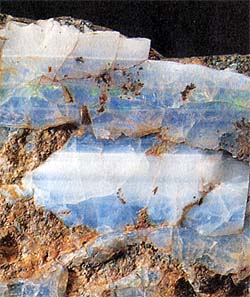 Diagnostic indication.
Diagnostic indication.
Under the action of ultraviolet rays an opal often shines a yellow or green color. It does not dissolve in no acids, except for a fluorine. At heating loses water and disintegrates, transforming in Quartz.
Origin provenance genesis.
Opal has a sedimentary origin.
It appears at besieging of silica and accumulation of tailings of skeletons of marine organisms.
Deposit minefield mine field occurrence subsoil.
The noble opal of various tints is delivered from Tanzania and United States. Most application use finds black opal, acting from Australia. A fiery opal is obtained in Mexico. In Italy an ordinary opal is found in Baldissero-kanavese, a province is Turin. Geyzerit a-plenty is round the geyser of Aylend in New Zeland and in Yello park (USA).
Use is on jeweller business.
Both noble opals and fiery opals are used as jewels of enormous value. The crooked surface is most suitable, to expose in all полноте brilliance and colouring, which distinguish noble opal. The most usual cutting is cabochon for brooches and ear-rings or sphere for necklaces. Mexican flame-coloured opal more frequent cut fasings.
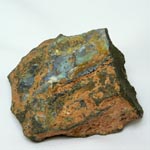
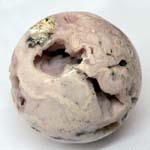
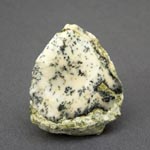
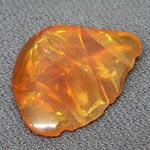

Up to beginning XX century the most high-quality opals acted from the deposit of Chervenica on extreme the east of Czekh. Avtraliyskie opals were then opened. Most known from the deposits of New Sonth Wales - Laytning-ridzh and Uayt-klifs, in Sonth Australia it Kuber-Pedi and Andamuka, in Queensland is Bulla-Krik and Byurku-River. Opals usually meet as thin (1-2 mm) прослоев or shallow seams, as a rule, in sandstones. Besides Australia of deposit of noble opal present in Brazil, Guatemala, Honduras. To Japan and USA (state is Nevada).
In Europe some time popular belief superstition exist back, that opals hoodoo. On the East this stone always was character of hope and loyalty. The game of flowers comes to light the best of all at treatment opal cabochons. In opal duplicates, so-called stratified opals, under thin noble an opal is underlaid ordinary opal or onyx. In triplet an opal skim is covered, in addition, yet by a protective layer from a mountain crystal. At imitations and imitations light opals or opal matrix for underlining of game of flowers are painted in a black color. Porous opals saturate with resins. In 70th of XX century the synthesis of noble opals was carried out.
Fiery opal. An opal got the name of flame-coloured for a flaming-orange color. Opalizaciya at such opals non-existent or shows up very poorly. Stone are milky-turbid often. The best fiery opals are transparent. Stone is sensible to any influences. The most considerable deposits are in Mexico (state Hidalgo and Keretaro), and also in Brazil, Guatemala, Honduras, USA, Turkey, CIS (Kazakhstan). To the market imitations act also from an opaleglass.
Varieties of noble opal: jirasole, or sun stone, transparent almost colourless opal with a wavy bluish ebb; irisopal - colourless or slightly brownish stone with a single-color ebb (from Mexico).
Usual opal. Usually opaque, does not have an iridescent game of flowers. The point-of-sale names are very numerous, for example: Agate-opal (Agate with layer opal), arboreal opal ("petrified tree"), honey yellow opal, suckling opal (translucent, white with an easy mother-of-pearl ebb, his opaque variety is named a porcelain opal); prasopal, or hrisopal - opaque, apple-green stone; waxen opal - rather yellow-brown with waxen brilliance; water opal, or hydrophane - "aged" noble opal, becoming turbid because of loss of water; absorbing water, temporally again becomes semilucent and opalescent.
Presently 90-95% world booty of noble opal is on Australia. His small displays are known in the CIS only - on Kamchatka and in Ukraine (CIS). Soviet scientists also carried out the synthesis of artificial synthetic opal with a well-organized internal structure, on the properties practically undistinctive from the famous Australian noble opals.

Opal in rhyolite. Sitting down. Seashore, Russia (CIS). A photo: © A.A. Evseev.


Opal. Oregon, USA. Opal (noble opal). Queensland, Australia. A photo: © A.A. Evseev.
